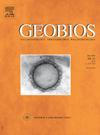Improved paired light and scanning electron microscope imaging technique for identifying nannofossils in Arctic sediments
IF 1.6
4区 地球科学
Q2 PALEONTOLOGY
引用次数: 0
Abstract
Calcareous nannofossils provide biostratigraphic age-markers for Pleistocene Arctic Ocean sediments. However, Pleistocene Arctic sediments are dominated by fine-grained terrigenous material, and commonly contain rare and poorly preserved coccolith specimens that can be difficult to identify under the light microscope (LM). Using paired observations of the same specimens under LM and a scanning electron microscope (SEM), we recently discovered that poorly preserved Noelaerhabdaceae specimens that cannot be identified at the species level were previously classified as Gephyrocapsa huxleyi using LM observations alone. Moreover, the visual resemblance under LM between G. huxleyi and another Quaternary marker species, Pseudoemiliania lacunosa, also led to occasional misdiagnosis. Given the importance of G. huxleyi and P. lacunosa for stratigraphic age control, this has potentially profound implications for our understanding of the paleoceanographic history of the Arctic, and also other ocean basins. This study focuses on challenges met in improving and applying the paired LM-SEM technique for observation of the same nannofossil specimens, and on its subsequent adjustments in the case of Quaternary Arctic sediments, which often contain low abundances of calcareous micro- and nannofossils. Moreover, we review morphological aspects and discuss potential difficulties in unambiguously identifying G. huxleyi, P. lacunosa and Gephyrocapsa under LM and illustrate the need of integrating SEM images – which can be difficult to obtain in low-diversity assemblage sediments dominated by silt and clay.
北极沉积物中纳米化石鉴定的改进配对光和扫描电镜成像技术
钙质纳米化石为更新世北冰洋沉积物提供了生物地层年龄标志。然而,更新世北极沉积物以细粒陆源物质为主,通常含有罕见且保存较差的球粒岩标本,在光学显微镜下难以识别。通过对同一标本在LM和扫描电镜(SEM)下的成对观察,我们最近发现,在物种水平上无法识别的保存较差的Noelaerhabdaceae标本,以前仅通过LM观察就被归类为Gephyrocapsa huxleyi。此外,赫胥黎与另一个第四纪标志种lacunosa Pseudoemiliania在LM下的视觉相似性也导致了偶尔的误诊。考虑到G. huxleyi和P. lacunosa对地层年龄控制的重要性,这对我们理解北极和其他海洋盆地的古海洋学历史具有潜在的深远意义。本研究的重点是改进和应用配对LM-SEM技术来观察相同的纳米化石标本所遇到的挑战,以及在第四纪北极沉积物中后续的调整,这些沉积物通常含有低丰度的钙质微化石和纳米化石。此外,我们回顾了形态学方面,并讨论了在LM下明确识别G. huxleyi, P. lacunosa和Gephyrocapsa的潜在困难,并说明了在淤泥和粘土主导的低多样性组合沉积物中难以获得的整合SEM图像的必要性。
本文章由计算机程序翻译,如有差异,请以英文原文为准。
求助全文
约1分钟内获得全文
求助全文
来源期刊

Geobios
地学-古生物学
CiteScore
3.30
自引率
6.20%
发文量
28
审稿时长
6-12 weeks
期刊介绍:
Geobios publishes bimonthly in English original peer-reviewed articles of international interest in any area of paleontology, paleobiology, paleoecology, paleobiogeography, (bio)stratigraphy and biogeochemistry. All taxonomic groups are treated, including microfossils, invertebrates, plants, vertebrates and ichnofossils.
Geobios welcomes descriptive papers based on original material (e.g. large Systematic Paleontology works), as well as more analytically and/or methodologically oriented papers, provided they offer strong and significant biochronological/biostratigraphical, paleobiogeographical, paleobiological and/or phylogenetic new insights and perspectices. A high priority level is given to synchronic and/or diachronic studies based on multi- or inter-disciplinary approaches mixing various fields of Earth and Life Sciences. Works based on extant data are also considered, provided they offer significant insights into geological-time studies.
 求助内容:
求助内容: 应助结果提醒方式:
应助结果提醒方式:


